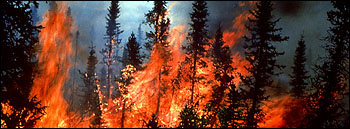


| |||
1998 was an extreme year for wildfire activity throughout the North American
and Russian boreal forests. More than 11 million hectares (110,000 square km)
burned that year (Kasischke et al 1999). Examination of NOAA Advanced Very High
Resolution Radiometer (AVHRR) and Landsat satellite images over the world’s
high northern latitude forests reveals a heavy peppering of burn scars across
the boreal landscape. Closer examination of those image data reveals the boreal
forest canopy to be a patchy mosaic of splotches where there are various stages
of plant regrowth in the wake of earlier fires. |
| ||
 Although
most people regard fire as a destructive force that should be fought
and quickly extinguished, the fact is the boreal forest evolved in the presence
of fire and adapted to it. Forrest Hall says it’s not a question of
if a given region of the boreal forest will burn, it’s a question of
when. Hall, a physicist at NASA’s Goddard Space Flight Center,
explains that wildfire is an integral part of the boreal ecosystem. Indeed, the
high northern latitude forests would be quite different were it not for frequent
fires (Hall 1999). |
The largest, most intense of boreal wildfires are called 'crown fires.' These explosive fires burn up into the forest canopy and spread quickly from treetop to treetop, releasing smoke and gases high up into the atmosphere. Crown fires are responsible for most of the areas burned in the boreal forests of North America and Eurasia. (Photograph courtesy Brian Stocks, Canadian Forest Service) | ||
"Fire is the mechanism by which the forest is continually regenerated," states Hall. Fires consume dead, decaying vegetation accumulating on the forest floor, thereby clearing the way for new growth. Some species, such as the jack pine, even rely on fire to spread their seeds. The jack pine produces "seratonous" (resin-filled) cones that are very durable. The cones remain dormant until a fire occurs and melts the resin. Then the cones pop open and the seeds fall or blow out. "In the Canadian boreal forest, aspen and jack pine are the most important ‘pioneer species’," observes Hall. "They are usually the first to grow back in a region that has been affected by fire. A few years after the fire, you typically see either dog-hair thick aspen stands or knee-high young jack pine trees sprouting all over the place." Then comes secondary growth of the other tree species common to the boreal region—spruce or fir trees. Once spruce trees reach the same height as the other species, they become competitively superior to the other trees. Spruce have better access to sunlight while shading the other trees with their more dense canopies. Consequently, the jack pine and aspen begin dying out in regions where spruce trees are plentiful. But, should another fire come and disturb this cycle, the more fire-tolerant jack pine and aspen regain the advantage and again proliferate. (At far northern latitudes and in most of the Siberian boreal forest—depending upon such variables as soil type and wetness, topography, and local climate—species such as jack pine don't fair well and the regeneration species are mostly shrubs and black spruce.) The amount of "standing biomass" (plants and trees) continually increases for 140 to 200 years after a fire; then the amount of standing biomass stabilizes and decreases as mature trees begin to die off. As plants die, fall to the ground and decay, the amount of carbon stored in the soil and ground moss rises over centuries to millennia. In this way, over geologic time, huge amounts of carbon have accumulated in the world’s boreal forest floor—about 37 percent of the carbon stored on land, and about 15 percent of the world’s total carbon content (Kasischke et al 1995). A Burning Issue
Of concern to Earth scientists is the impact widespread boreal fires have on climate. Fires release huge amounts of smoke, carbon dioxide, and methane into the atmosphere. These are greenhouse gases that act like "insulation" in the atmosphere to help trap and retain heat emitted from the surface. Some scientists are concerned that extreme fire seasons in the boreal forest, like last year’s, may contribute to global warming. Others point out that when a region is disturbed by fire, there is vigorous regrowth that could offset global warming. The rationale is that while the younger plants are growing back they are absorbing carbon dioxide back out of the atmosphere and using the carbon to build plant structures. Over the long term, does fire render the boreal ecosystem a "source" or "sink" of carbon? |
| ||